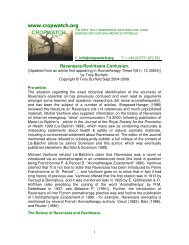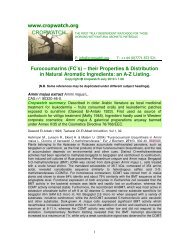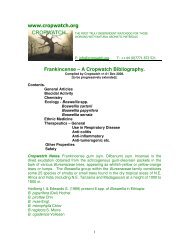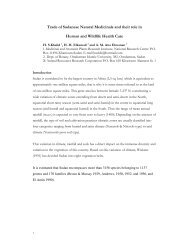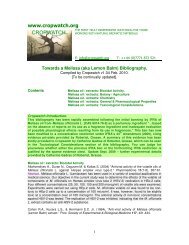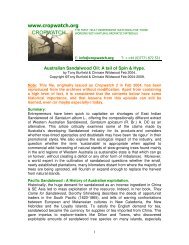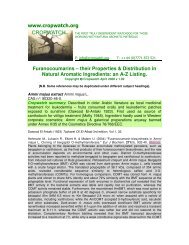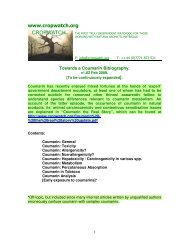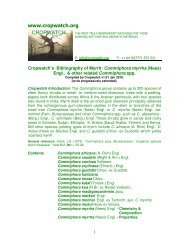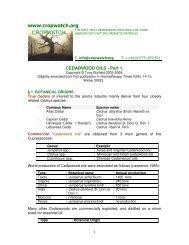Sandalwood Biblio - Cropwatch
Sandalwood Biblio - Cropwatch
Sandalwood Biblio - Cropwatch
Create successful ePaper yourself
Turn your PDF publications into a flip-book with our unique Google optimized e-Paper software.
Bird K. (2008) "Lush secures supply of sustainable sandalwood." CosmeticsDesign-Europe<br />
21.02.2008. <strong>Cropwatch</strong> comments. Further move illustrating rising tendency of natural aromatic<br />
ingredient users to by-pass essential oil traders and sign contracts directly with producers. In this<br />
case the report notes the deal is to buy Indian sandalwood from the Australian TFS Corporation,<br />
which expects sandalwood oil to be available from its'plantations by 2011. For full story - see<br />
http://www.cosmeticsdesign-europe.com/news/ng.aspid=83433-lush-tfs-sandlewood<br />
Bird K. (2008) "Fragrance house sources sustainable ingredients." CosmeticsDesign-Europe<br />
07.02.2008. <strong>Cropwatch</strong> comments. Givaudin announced a partnership with Mount Romance,<br />
according to the article, and we are also informed that Givaudin claim to be the first fragrance<br />
house using an aboriginal source of wood, since we are told that the sandalwood is harvested by<br />
aboriginal communities in SW Australia, and inspected by the independent indigenous<br />
certification body, the Songman Circle of Wisdom. Full details can be seen at<br />
http://www.cosmeticsdesign-europe.com/news/ng.aspn=83107-givaudan-fragrance-naturalehtical.<br />
Mount Romance’s involvement with emu oil was quite well known (5,000 litres claimed to<br />
have been produced in 1997), as is Stephen Birkbeck’s (MD at Mount Romance) previous trackrecord<br />
in crocodile & turtle farming. Given this animal-product-exploitation scenario, the “ethical<br />
sustainability relationship” between Givaudin & Mount Romance woulf have probably ring hollow<br />
with many ecology-concious consumers & vegetarians, at least. Interestingly, the farm gate value<br />
of the emu-farming industry was put at $6-8 million/y (CoAS 2003), compared with a valuation of<br />
(only) $12m for the whole of the Australian tea tree oil industry. Opposition to emu farming in<br />
Australia by the Australian Royal Society for the Prevention of Cruelty to Animals, can be viewed<br />
at http://www.rspca.org.au/pdf/B_policystatements.pdf Further comments. Aveda also have an<br />
agreement with Mount Romance for supply steam-distilled <strong>Sandalwood</strong> oil (instead, apparently,<br />
of the solvent extract initially marketed by Mount Romance as ‘oil’) More details, as well as their<br />
involvement with the Ingenous Communities of Mardu Peoples of Kuktabubba for harvested<br />
sandalwood can be seen at http://aveda.aveda.com/protect/we/sandalwood.asp.<br />
Bolt C. (2001) “Tax scheme controversy fells plantation timber company” The Financial Review<br />
31 July 2001 p12.<br />
Bradfield A.E., Francis E.M., Penfold A.R. & Simonsen J.L. (1936) "Lanceol, a sesquiterpene–<br />
alcohol from the oil of Santalum lanceolatum. Part I." J. Chem. Soc., 1936, 1619 - 1625,<br />
Brand J.E. & Jones P.J. (year) “The influence of landforms on sandalwood (Santalum spicatum<br />
(R.Br) A.DC.) size structure & density in the North East Goldfields, Western Australia.” Rangeland<br />
Journal 24(2), 219-226.<br />
Brand J.E. (1993) “Preliminary observations on ecotypic variations in Santalum spicatum. 2.<br />
Genotypic variation.” Mulga Research Centre Journal 11, 13-19.<br />
Brand, J.E. (1994). “Genotypic variation in Santalum album.” <strong>Sandalwood</strong> Research Newsletter 2,<br />
2–4.<br />
Brand J.E. (1999) “Ecology of sandalwood (Santalum spicatum) near Paynes Find & Menzies,<br />
Western Australia: size structure & dry-sided stems” Rangeland Journal 21(2), 220-228.<br />
Abstract. Population size structure of sandalwood (Santalum spicatum) was studied on four<br />
pastoral leases near Paynes Find and Menzies, in semi-arid Western Australia. Stem diameter,<br />
height, height to crown and the orientation of dry-sided stems were recorded for 1017 individual<br />
sandalwood. Populations of S. spicatum at Paynes Find contained only mature trees, indicating<br />
no successful recruitment for at least 30 years. In contrast, populations of S. spicatum at Menzies<br />
had a high proportion of seedlings and saplings. Crown measurements of mature S. spicatum<br />
trees indicated high grazing intensity at Paynes Find: mean height to crown at Paynes Find (147-<br />
148 cm) was significantly higher than Menzies (92-94 cm). Dry-side percentage differed<br />
significantly between directional faces, consistent with sun damage. Highest mean dry-side<br />
percentages were on stem sides facing the sun between midday and late afternoon: west, northwest,<br />
south-west and north. This directional pattern was the same between pastoral leases, and<br />
8





